Lee
and Karen Duquette,
The Two RV Gypsies
drove to Oklahoma State Capitol's Building
2300 N. Lincoln Blvd
Oklahoma City, OK 73105
October 11, 2022
|
|
 |
|
|
The Oklahoma State Capitol is the house of government
of the U.S. state of Oklahoma. It is the building that houses the
Oklahoma Legislature and executive branch offices. It is located along
Lincoln Boulevard in Oklahoma City and contains 452,508 square feet
of floor area. The present structure includes a dome completed in
2002.
Oklahoma's first capital was Guthrie, Oklahoma, but
it moved to Oklahoma City in 1910. Construction began on the Oklahoma
State Capitol in 1914 and was completed in 1917. Originally, it housed
the judicial branch of Oklahoma, but the state's high courts moved
most of their operations to the Oklahoma Judicial Center in 2011,
leaving only the Supreme Court Hearing Chamber in the capitol building.
The state capitol complex is the only state capitol
grounds in the United States with active oil rigs. The capitol building
is directly atop the Oklahoma City Oil Field.
|
 |
 |
Below: The Tribal Flag area |
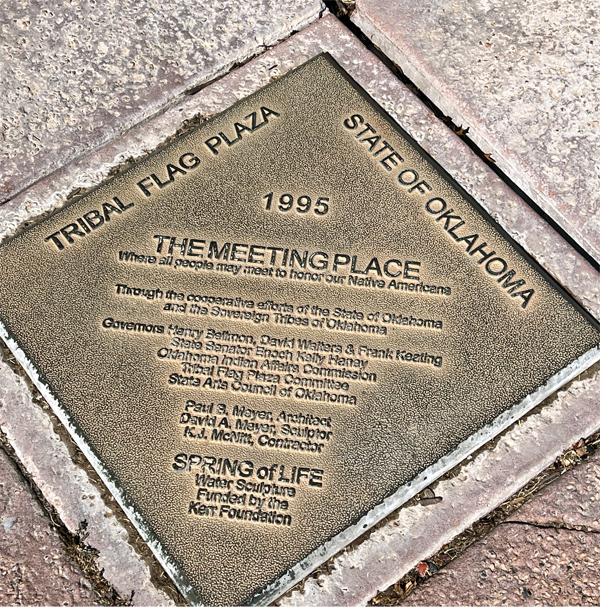 |
Below: Native American artist
and former state politician Enoch Kelly Haney crafted the 17-foot tall
6,000 pound bronze sculpture "The Guardian" shown
atop the stare Capitol. The statue holds a staff that reaches 22 feet
into the sky.This monumental project was completed in ten months and
demanded 4,000 pounds of bronze, which was cast in 50 sections. Haney’s
own family served as models for this historic piece. Haney’s son William
and Haney’s grandson, Enoch, inspired the guardian’s eyes and cheeks
respectively. Inside the rotunda, visitors can view a nine-foot replica
of The Guardian. |
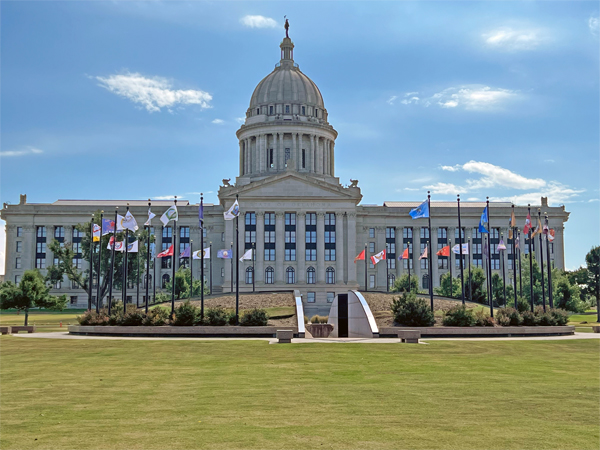 |
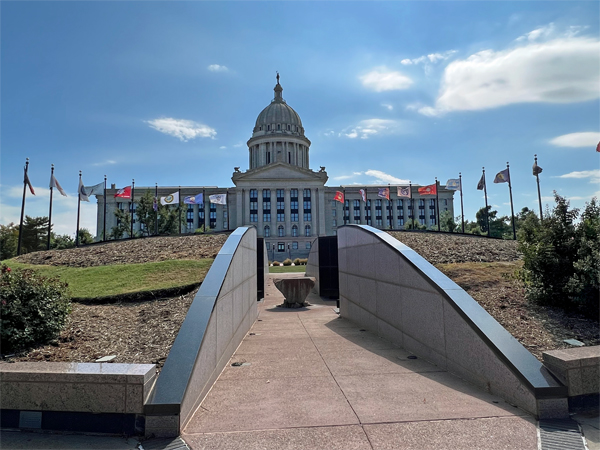 |
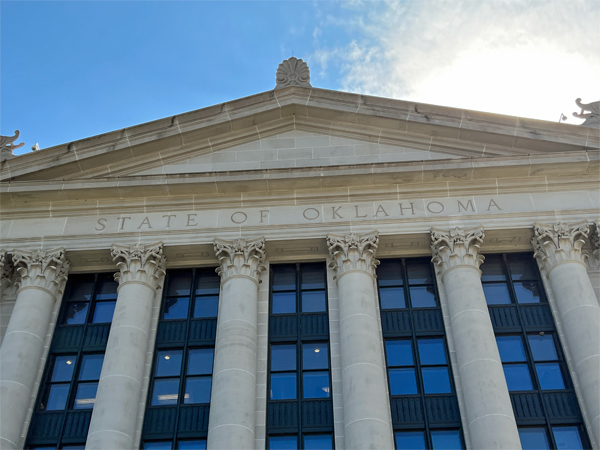 |
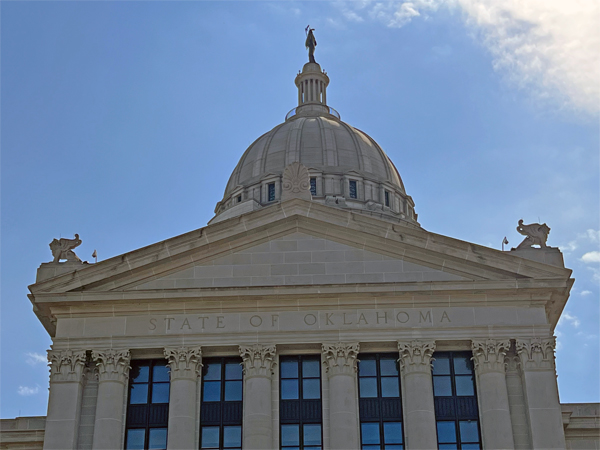 |
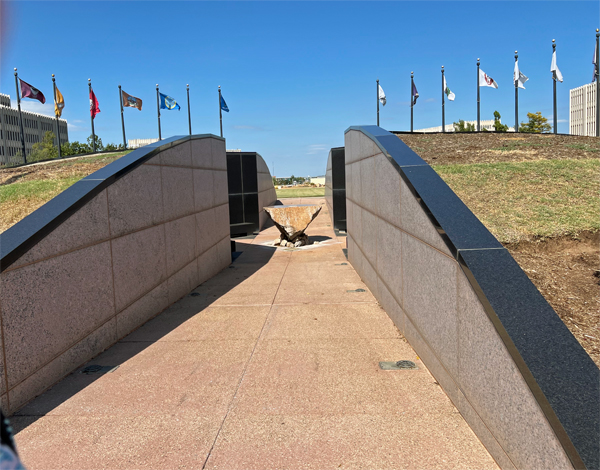 |
 |
 |
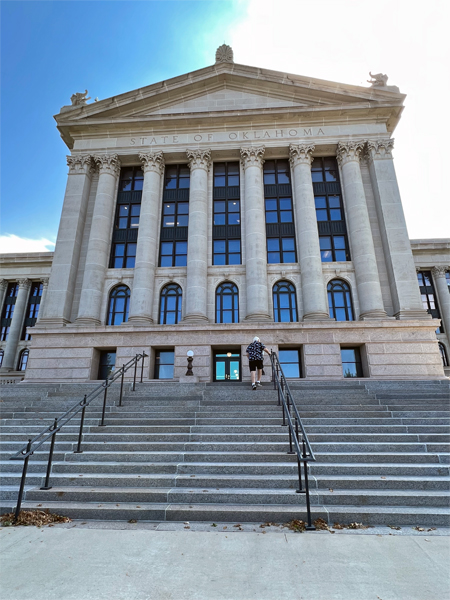 |
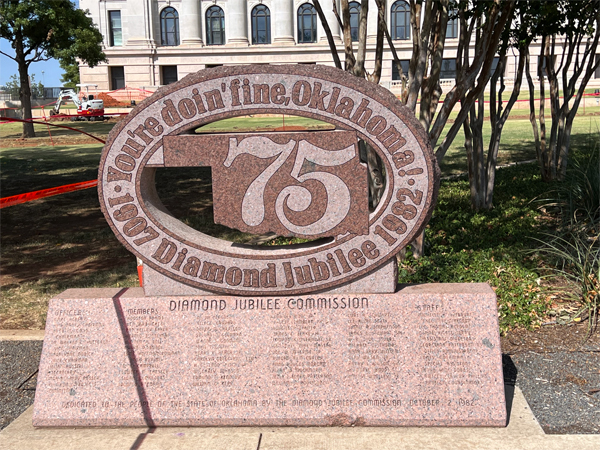 |
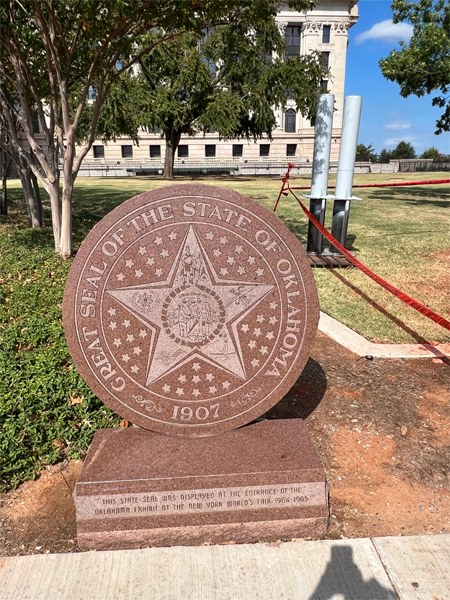 |
Below: This monumental tribute
to Native Americans was dedicated on June 4, 1989. The title refers
to President Andrew Jackson’s vow to Native Americans that they shall
possess their land “as long as the grass grows and the rivers run".
The bronze statue is 15-feet in height. |
|
|
 |
 |
Below: Before going inside
the building, Lee and Karen Duquette walked around the grounds and photographed
the historical stones on the ground. Be sure to scroll down the page
to see the amazing inside of the building. |
1200 AD Mississippian Culture Peaks
at Spiro Mounds |
Below: 1541 First Europeans to Explore
Oklahoma |
 |
 |
Below: 1750 Osages Push Wichitas
To Rio River |
Below: 1750 Caddos to Red River |
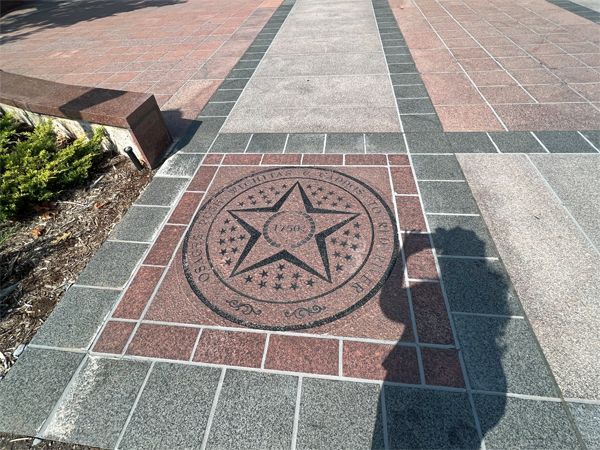 |
 |
Below: 1821- Santa FE Trail
and TX Road Cross Ok |
Below: 1824- Gibson First Fort Established |
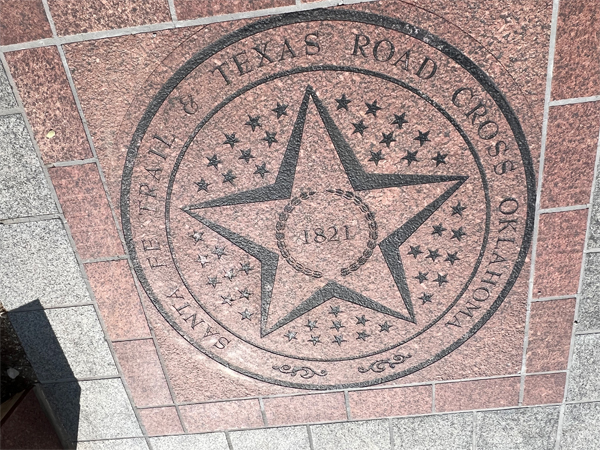 |
 |
Below: 1865-1885 Cattle Trails
Cross Oklahoma |
Below: 1869 - Fort Sill is Established |
 |
 |
Below: 1870 MK&T Rail
Service began
in Indian Territory |
Below: 1870 - Coal Mining started near
city of McAlester |
 |
 |
Below: 1949 - First Turnpike |
Below: 1959 - Oklahoma voters repeal Alcohol
prohibition |
 |
 |
Below: 1995 Bombing of The
Alfred P Murrah Red Building |
 |
Below: A bronze statue tribute
to the Romantic Riders of The Range - Dimensions: 140" x 87"
x 37". |
Description: Constance Whitney
Warren’s intricately detailed sculpture of a bucking bronco and a steadfast
cowboy in wool chaps was the first sculpture installed on the grounds
of Oklahoma's State Capitol. Known as “a bronze tribute to the romantic
riders of the range” the sculpture represents Oklahoma history as seen
through the eyes of the cowboy that rode across her land on his trustee
steed. |
 |
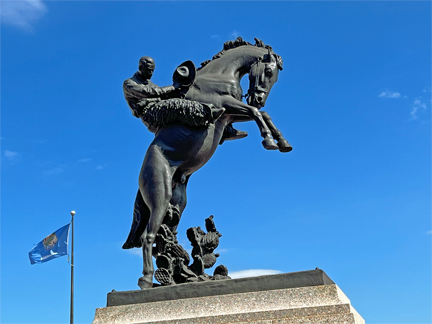 |
Then it was time for the two
RV Gypsies, Lee and Karen Duquette, to enter the building. |
 |
Below: Amazing Rotunda ceilings |
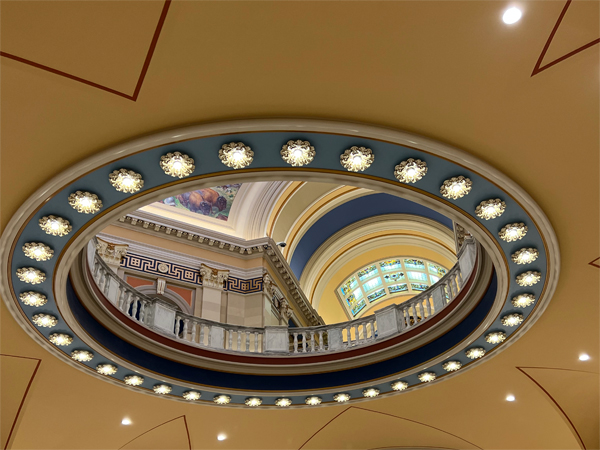 |
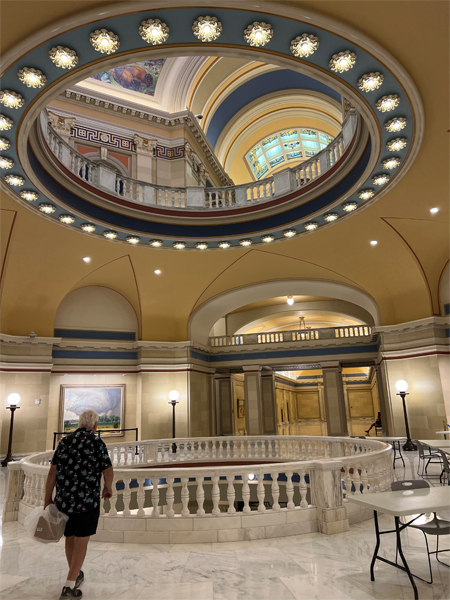 |
 |
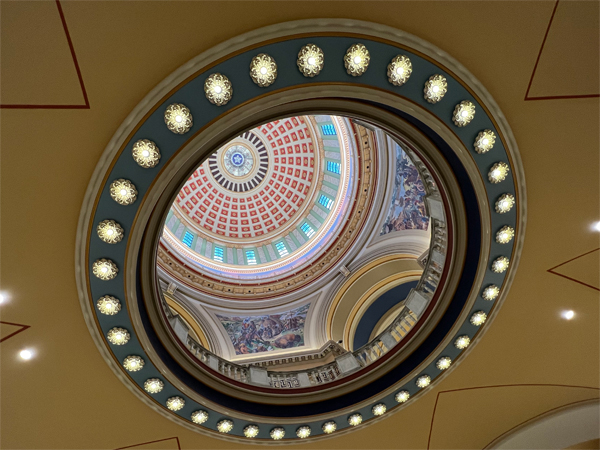 |
 |
Below: There are
four historic acrylic paintings on linen canvas by Charles Banks Wilson,
each 17' x 13' in size.
Discovery and Exploration - 1541-1820; Frontier
Trade - 1790-1830; Indian Immigration - 1820 -1885;
and Non-Indian settlement- 1870-1906. |
|
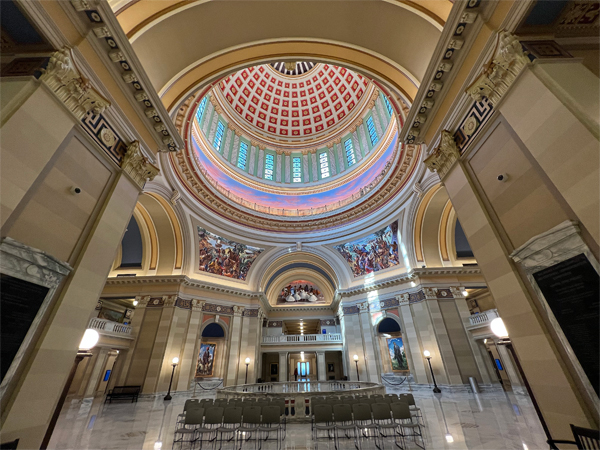 |
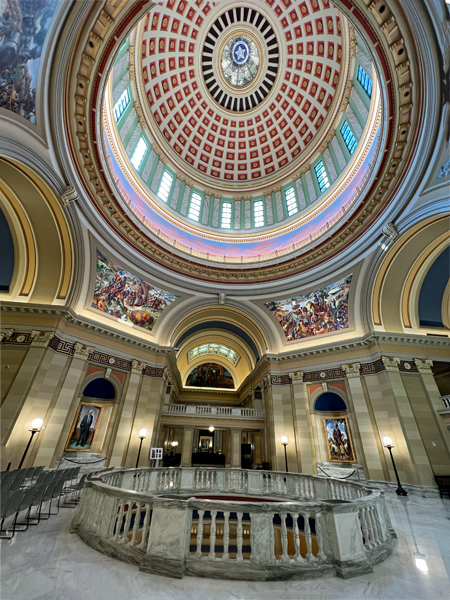 |
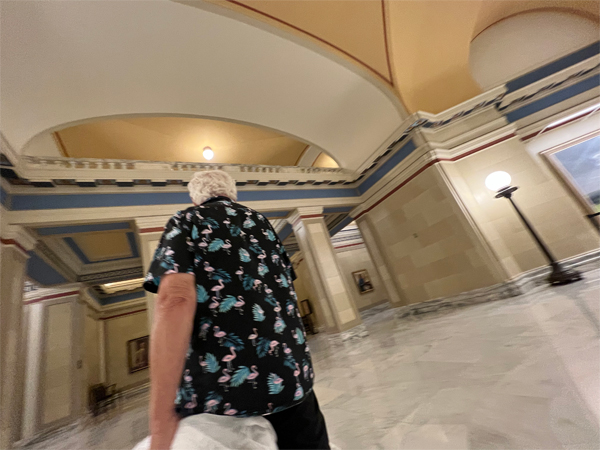 |
Below: Fancy restrooms |
 |
 |
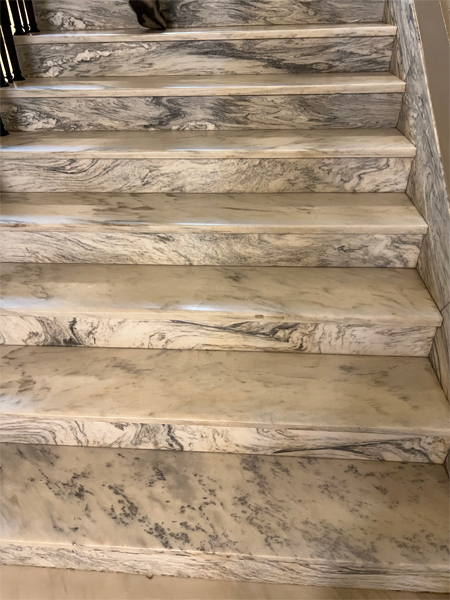 |
 |
Below:
Oklahoma Black Gold by Jeff Dodd - oil on linen 11' x 20' |
|
Oklahoma Black Gold celebrates
the 100th anniversary of the oil and gas industry in Oklahoma. The
wooden structure on the left side of the twenty-two foot mural represents
Oklahoma's first attempts at
drilling. The oil rig on the right side represents the boundless future
of the state. The two roughnecks
in the middle of the epic piece display the physical strength and stamina
necessary to work in the oil
patch as the Oklahoma state flag blankets the state through “booms”
and “busts.”
|
Below: We Belong to the
Land by Jeff Dodd - - Oil on Linen 11' x 20' |
Description
We Belong to the Land features the contribution agriculture has made
to the history of Oklahoma.
Towards the back of the piece the great seal of Oklahoma shines behind
a dusty cowboy rustling
cattle. A weary pioneer woman wipes the sweat from her brow as a farmer
on the opposite side of
the mural plows the rich Oklahoma earth. The mural depicts the evolution
of agriculture in Oklahoma
from early settler days through history where technological advancements
have increased agricultural productivity and contributed to overall
economic growth
|
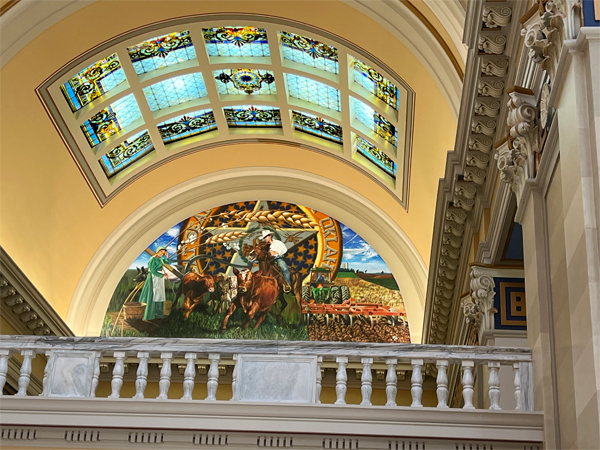
|
Below: Flight of Spirit
- located below the Ring of Honor - by Mike Larsen, 11' x 22' |
|
Flight of Spirit merges
the tragic history of Native Americans with the hope and renewal of
modern accomplishments. Behind the illuminated ballerinas is Larson’s
depiction of the Trail of Tears. Five geese soar over the displaced
Native Americans. The geese symbolize the grace and spirit of the
five ballerinas. Larson reserves his customary enlargement of hands
and feet for the traditionally dressed Native Americans who stand tall
behind the ballerinas. His depiction of the ballerinas is strictly representations
in that the painted figures have analogous facial features and proportions |
 |
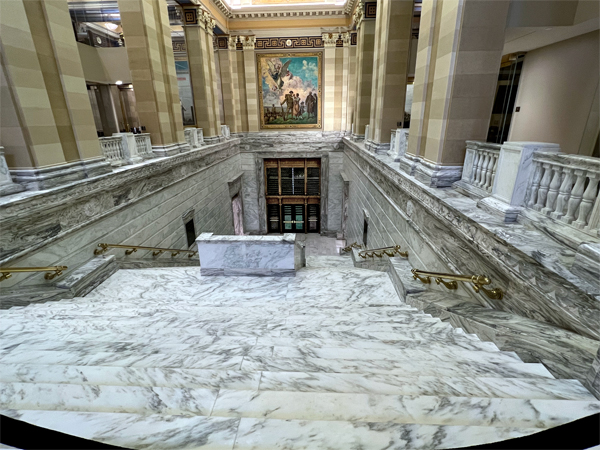 |
 |
 |
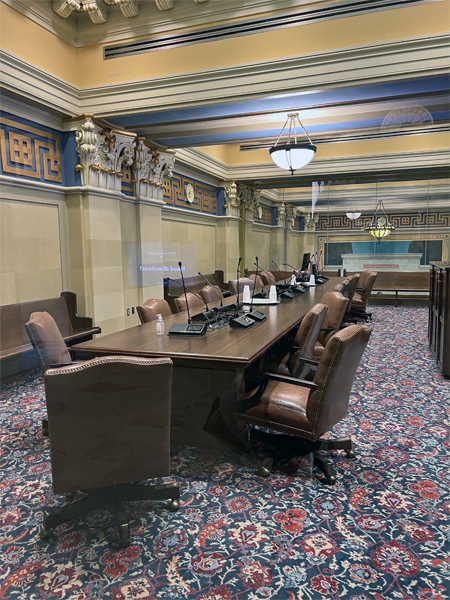 |
Below: Weighing almost 3,500
pounds, a 14-foot bronze relief sculpture of the state seal rests in
the ground-floor rotunda and replaces the terrazzo state seal featuring
a slightly different design installed in 1966. The restoration team
commissioned the bronze seal from the Crucible Foundry – a locally-owned
business in Norman, Oklahoma – which also cast The Guardian, the statue
created by Enoch Kelly Haney, that gazes over the Capitol Complex from
the top of the dome. |

|

|
Below: A nine-foot
replica of The Guardian, which stands above the Capitol building.
It was described earlier towards the top of this page.
|
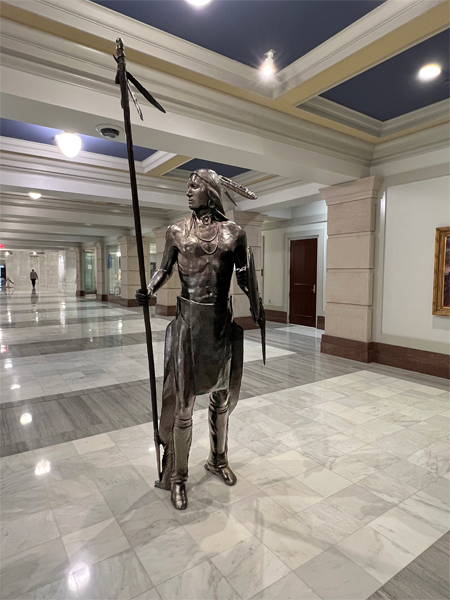 |
Below: "The Earth
and I are One" by Enoch Kelly Haney, acrylic on Canvas, 48"
x 36" |
Description
The Earth and I are One is a mystical painting of a meditating
Native American sitting amongst Oklahoma's state wildflower, the Indian
blanket.
The Native American’s translucent physical being merges with the wonders
of nature that surround him. The state bird of Oklahoma, a scissortail
flycatcher, and America’s national fowl, the bald eagle, hover above
the native peacemaker as if guarding him. The Oklahoma natural splendor
envelops the figure creating and atmosphere of calming peace.
The symbolism within this piece is a true testament to the artist’s
love for his native state. The crystal
blue lake and the velvety green grass are common occurrences throughout
Oklahoma. The overall
feel of the painting is that of Oklahomans’ deep respect and admiration
for the natural beauty that
surrounds us. Accordingly, The Earth and I are One was dedicated on
Earth Day, 1990 |
|
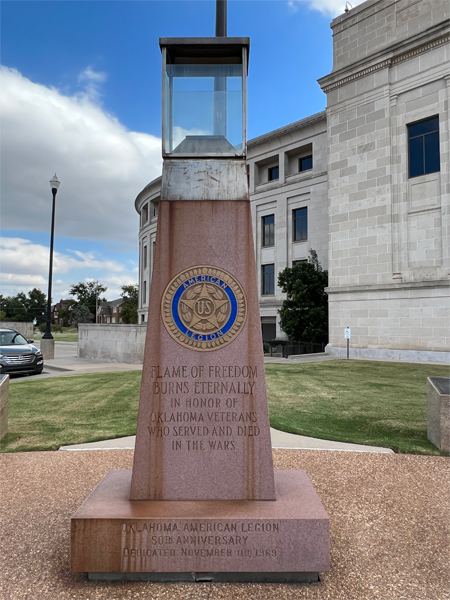 |
 |
 |
|

















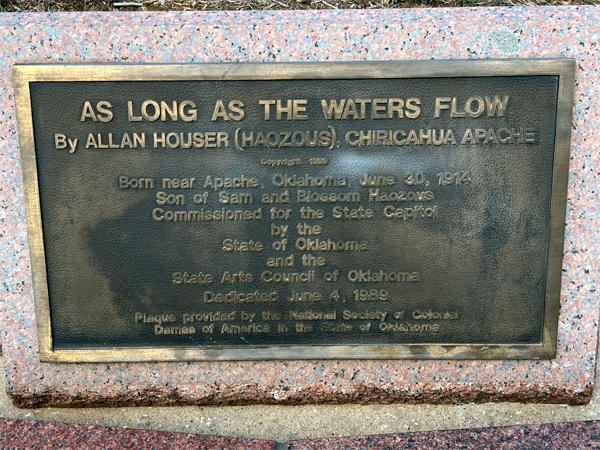































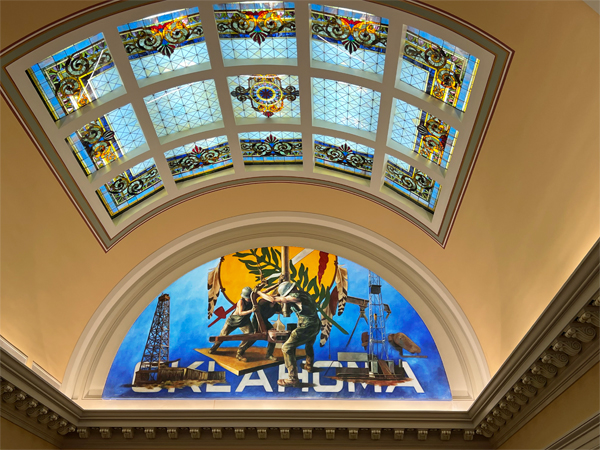







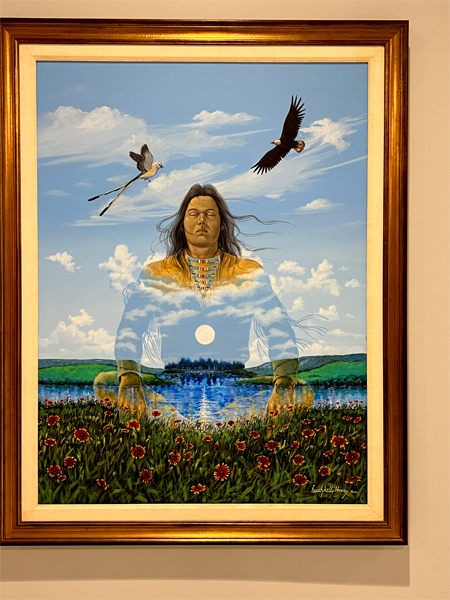






























 Continue on to
Continue on to 
